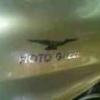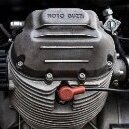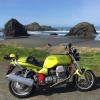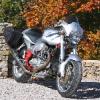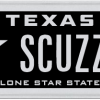-
Posts
2,345 -
Joined
-
Last visited
-
Days Won
61
Kiwi_Roy last won the day on November 26 2021
Kiwi_Roy had the most liked content!
Profile Information
-
Location
Cell 401
-
My bike(s)
VII Sport & Griso long gone72 Eldorado, V7iii Special 76 Convert aka Magic Carpet Ride
Kiwi_Roy's Achievements
-
Kiwi_Roy started following More power from the 1200 8V and speedo
-
I didn't use a Sigma, I used a Speedhut the sensor was mounted in place of age speedo cable at the gearbox It worked very well I highly recommend the Speedhut line. https://www.speedhut.com
-
Well, I had a green V11 Sport and I had a Griso for a while, what more could I ask for? Perhaps the V8 racer, it would be fun to roll up for coffee on that.
-
The Go Winkie light is connected to the supply to the ECU Obviously if you dont have 12 Volts to the ECU it won't spark or power up the injectors It was Doc that gave it the name, blame him.
-
I swear by plain old Vaseline for switch contacts, its what I have been using for at least the last 60 years.
-
You can actually get access to a significant portion of the fuel on the Right hand side of the tank. The fuel is delivered to the pump from the left hand side of the tank but it returns it to the Right Hand side. I took the return fitting out and extended it up with a 45 at the top side so it would throw the fuel over to the Left Hand side. In theory if the tank is low and you tilt it over to the Left it should take a while to migrate back to the Right.
-
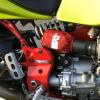
ANSWERED OMRON G8HE-1C7T-R-DC12 DC12V or Equivalent (CIT A11CSQ12VDC1.5R?)
Kiwi_Roy replied to p6x's topic in Technical Topics
A stronger coil might lead the manufacturer to use a stronger contact spring, if you look at the specs they have quite a good current rating but always less than the Normally Open contact. If you look at all Carl's Guzzi drawings around that era only the 1999 VII Sport and the 2000 Quota put any significant current through the Normally Closed contact of the Start relay all the rest of the bikes (2000 Bassa, 2000 Jackal, 2002 Nevada, 2002 Stone & 2004 VII Catalytic) only use the Start relay N/C to switch the headlight Relay coil current ~100 milliamps there must have been a reason for that. I know my 1999 would drop as much as 1 Volt between the battery and the Voltage regulator at times (normally ~0.5 Volt) which I blame for destroying the regulator. The charging current goes up exponentially with Voltage, I'm sure there are other bikes that switch the headlight current through the Normally Closed contact but I can't help thinking its a bad idea. IMHO the Voltage reference for the regulator should be as true to the battery Voltage as possible, I always meant to try feeding the regulator reference from one of the lightly loaded ECU relay, I will never get around to doing that now. Measure the battery Positive to the black wire at the regulator before then after wiggling the two relays in their sockets you will see what I mean. -

ANSWERED OMRON G8HE-1C7T-R-DC12 DC12V or Equivalent (CIT A11CSQ12VDC1.5R?)
Kiwi_Roy replied to p6x's topic in Technical Topics
A stronger coil should lead to a better contact, If you look at the specs of a Normally Open contact you will see it has a higher rating than the Normally Closed contact, this would be a function of the contact pressure. -
The one on my VII Sport was, If you look at the outside of the case and see large screws holding the pole pieces in place its electro magnet, most of the permanent magnets I have seen are just glued in place. You can barely see the screws in this picture, an impact driver is useful if you have to remove them. As an apprentice we would take the coils out and re-tape them with linen tape, often solves starter problems. (I'm not an auto electrician)
-
I assume the clean brush holder on the Left is Suzuki while the dirty one on the right is Aermacchi. It looks as though the insulated brush on the Suzuki needs to be relocated to 12 O'clock to make it the same as the Aermacchi, that would change the direction.
-
Its worth a try but keep the same field arrangement the Suzuki currently has 2 Shunt coils and 2 series coils, the armature will draw as much cauurent as the load calls for. A picture is worth 1000 words.
-
There are several different ways of wiring a starter motor, most are wired in series because thats a high torque arrangement and will wind up to quite a high speed. Traction motors are normally series type. The Suzuki motor as you describe it is a compound motor, they can develop high torque but don't have such a high speed. The two "Shunt Fields" coils wired from positive to ground will be a higher resistance (over 1 Ohm). The Series fields are usually low, say 0.2 Ohms It sounds like you are thinking of using the Aeromachi armature inside the Suzuki fields in order to have the right gear arrangement, how do you know it will fit? How do you know which way it will rotate. Why don't you try overhauling the Aeromachi starter, it will probably be easier than trying to reverse the Suzuki one, A few pictures might help. Perhaps a wiring sketch. Do you have a document on the Aeromachi starter?
-
To reverse rotation you must reverse either the current through the armature or through the fields, you seem to understand that It doesn't matter which order the items are in just so long as the current flow is in the right direction.
-
It might well be seeping through the wires between strands, pretty hard to seal, you sometimes see a dedicated seal with solid wires potted for that reason. On the same note the rotation sensors leak through the body, the transition between the centre steel core and teflon is almost impossible to seal.
-
If you separate the two joints they must go back the same, I think you should find a paint mark to get the correct orientation.


